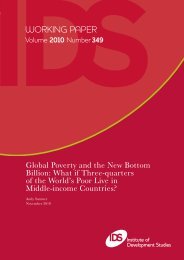Patterns of time use in Tanzania: how to make public investment in ...
Patterns of time use in Tanzania: how to make public investment in ...
Patterns of time use in Tanzania: how to make public investment in ...
Create successful ePaper yourself
Turn your PDF publications into a flip-book with our unique Google optimized e-Paper software.
Annex 4 – Methodology<br />
Data description (TUS/ILFS 2006)<br />
As already mentioned <strong>in</strong> the <strong>in</strong>troduction, this paper is based on the <strong>time</strong> <strong>use</strong><br />
module <strong>of</strong> the <strong>Tanzania</strong>n Integrated Labour Force Survey (ILFS). The TUS<br />
2006 is the first <strong>of</strong> its k<strong>in</strong>d <strong>in</strong> <strong>Tanzania</strong>. One out <strong>of</strong> every five ho<strong>use</strong>holds who<br />
<strong>to</strong>ok part <strong>in</strong> the ILFS was <strong>in</strong>terviewed for the <strong>time</strong> <strong>use</strong> module as well. The<br />
sample consists <strong>of</strong> 10,553 <strong>in</strong>dividuals aged 5 years or above (correspond<strong>in</strong>g <strong>to</strong><br />
more than 3,000 ho<strong>use</strong>holds) weighted <strong>in</strong> order <strong>to</strong> be representative at the<br />
country level. Respondents were <strong>in</strong>terviewed for 7 consecutive days 11 and<br />
asked what they had done dur<strong>in</strong>g the 24 hours (a unique <strong>time</strong> slot was<br />
created for the night hours 12am-4am). The data conta<strong>in</strong>s 20-1 hour <strong>time</strong>- slots<br />
per day <strong>in</strong> which respondents could name up <strong>to</strong> five activities <strong>in</strong>dicat<strong>in</strong>g<br />
whether the activities were carried out simultaneously or separately from<br />
other activities (Budlender, 2008).<br />
Refer <strong>to</strong> Annex 1 for the detailed categorization <strong>of</strong> activities.<br />
Aggregation <strong>of</strong> activities: rationale<br />
For the purpose <strong>of</strong> this paper we have aggregated activities <strong>in</strong><strong>to</strong> broader<br />
categories. The aggregations are s<strong>how</strong>n <strong>in</strong> table A1 <strong>of</strong> Annex 2 and Table A2<br />
<strong>of</strong> Annex 3.<br />
First <strong>of</strong> all, given the TUS sample is rather small if compared <strong>to</strong> the real<br />
population (aged 5 years and above) <strong>to</strong>o detailed disaggregations would not<br />
generate reliable results (Budlender, 2008). This is one <strong>of</strong> our reasons for<br />
aggregat<strong>in</strong>g activities: activities were either aggregated or highlighted with a<br />
star <strong>to</strong> <strong>in</strong>dicate that caution <strong>in</strong> <strong>in</strong>terpretation <strong>of</strong> the results whenever activities<br />
were carried out by less than 5% <strong>of</strong> the population.<br />
Moreover, the ma<strong>in</strong> aim <strong>of</strong> the paper, as well as that <strong>of</strong> the TUS, is <strong>to</strong> s<strong>in</strong>gle<br />
out activities where gender distribution is skewed the most. Analyz<strong>in</strong>g those<br />
activities which are <strong>of</strong>ten not <strong>in</strong>cluded <strong>in</strong> the standard def<strong>in</strong>ition <strong>of</strong><br />
employment and are usually carried out by women is vital consider<strong>in</strong>g the<br />
important role that they play for the welfare <strong>of</strong> the country (Analytical<br />
Report-key f<strong>in</strong>d<strong>in</strong>gs). Aggregation <strong>of</strong> activities was carried out <strong>in</strong> such a way<br />
as <strong>to</strong> highlight such gender patterns.<br />
Calculation <strong>of</strong> activities <strong>in</strong> a day, and <strong>how</strong> <strong>to</strong> deal with simultaneity<br />
11 Not all respondents have been <strong>in</strong>terviewed for the same number <strong>of</strong> days; diary <strong>in</strong>formation<br />
on activities is reported for most <strong>of</strong> the respondents for 6 or 7 days.<br />
49

















